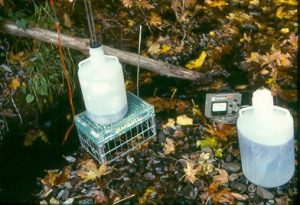Dissolved Oxygen

The concentration of dissolved oxygen (DO) in streams and lakes strongly influences aquatic organisms because fish and many other aquatic organisms depend on respiration for energy. Oxygen is considered sparingly soluble with oxygen dissolved in water representing less than 1% by weight compared to 21% in the atmosphere. Depressing this already low DO concentration can stress aerobic organisms. Sanitary engineers have long understood the need to manage oxygen levels below municipal and industrial waste treatment plants to avoid depressing oxygen to deleterious levels.
The Alsea Watershed Study monitored concentrations of dissolved oxygen associated with the two treatment watersheds (Needle Branch and Deer Creek) and control watershed (Flynn Creek). The Alsea and a handful of other forest watershed studies documented that timber harvesting without precautions could depress DO concentrations.
Key mechanisms by which harvesting depresses DO concentrations in streams include an increase in stream temperature with loss of canopy near the stream and a resulting increase in insolation (the solubility of oxygen in water is inversely related to water temperature); increased oxygen demand from fresh fine slash (oxygen demand is referred to as biochemical oxygen demand and includes respiration and chemical oxidation of organic and inorganic materials), and impoundment of the channel which reduces input of oxygen from the atmosphere into water experiencing an oxygen deficit (below saturation). The rate of oxygen exchange for a given level of oxygen deficit is referred to as the reaeration rate.
The Alsea Watershed Study also showed that by maintaining shade (riparian management zone or area) and keeping fresh slash out of the stream, DO concentrations could be maintained near the concentrations observed for unmanaged reaches. Oregon State University supported a number of research projects designed to understand where streams might be susceptible to deleterious depressions of DO (either in surface or subsurface flows) and how to manage to avoid negative impacts.
For more information on this work, see papers and theses by Berry (1975), Holtje (1971), Ice (1978, 1990), Ponce (1973), and (Skaugset 1980). A chapter by Ice in the book on the Alsea Watershed Study, edited by Dr. John Stednick of Colorado State University, summarizes some of the data and lessons learned about DO concentrations in managed forests. Another summary is found in the proceedings of the 2002 Watershed Management Council Biennial Meeting (Ice 2006). For additional information about DO concentrations in forest streams outside the Pacific Northwest see Ice and Sugden (2003).
References
Berry, J.D. 1975. Modeling the impact of logging debris on the dissolved oxygen balance of small mountain streams. MS thesis. Oregon State University Department of Forest Engineering.
Holtje, R.K. 1971. Reaeration in small mountain streams. Ph.D. thesis. Oregon State University Department of Forest Engineering.
Ice, G.G. 1978. Reaeration in a turbulent stream system. Ph.D. thesis. Oregon State University Department of Forest Engineering.
Ice, G.G. 1990. Dissolved oxygen and woody debris: Detecting sensitive forest streams. 333 346 in Wilhelm, S.C., and Gulliver, J.S. (eds.). Air-water mass transfer: Selected papers from the second international symposium on gas transfer at water surfaces. New York: American Society of Civil Engineers.
Ice, G. 2006. Water temperature and dissolved oxygen: Are state water quality standards achievable for forest streams? In Proceedings of the Ninth Biennial Watershed Management Council Conference, ed. W. Slaughter and N. Berg, 295-300. Available at: http://ucanr.org/sites/wrc/pdfs/WRCReport107_WMC02.pdf
Ice. G. 2008. Stream temperature and dissolved oxygen. Chapter 3 in Hydrological and biological responses to forest practices: The Alsea watershed study, ed. J. Stednick, 37-54. New York: Springer Science + Business Media, LLC.
Ice, G. and B. Sugden. 2003. Summer dissolved oxygen concentrations in forested streams of northern Louisiana. Southern Journal of Applied Forestry 27(2):92-99.
Ponce,S.L. 1973. The biochemical oxygen demand of Douglas-fir needles and twigs, western hemlock needles and red alder leaves in stream water.MS thesis. Oregon State University.
Skaugset, A.E. 1980. Fine organic debris and dissolved oxygen in streambed gravels in the Oregon Coast Range. MS thesis. Oregon State University Department of Forest Engineering.
